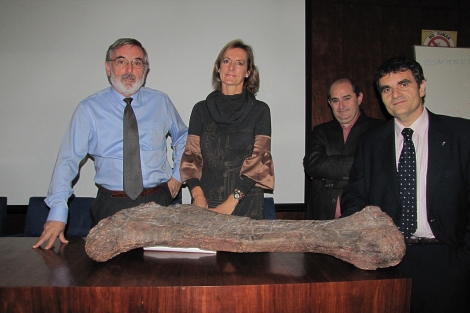T. rex‘s athleticism (and its rear end) has been given a makeover by University of Alberta graduate student Scott Persons. His extensive research shows that powerful tail muscles made the giant carnivore one of the fastest moving hunters of its time. As Persons says, «contrary to earlier theories, T. rex had more than just junk in its trunk.» |  |





The first excavations at the Audoin quarries in the town of Angeac, in the Charente region of south-western France, have confirmed that the site is one of the richest dinosaur fossil deposits in the country. Coordinated by the Musée d’Angoulême and the Géosciences Rennes laboratory (CNRS / Université de Rennes 1), the project involved researchers from CNRS and the Muséum National d’Histoire Naturelle (French Natural History Museum). With more than 400 bones brought to light, this site is remarkable both for the quantity of discoveries and their state of preservation. |  |
Los especialistas han hallado en el yacimiento de Ana de la localidad de Cinctorres (Castellón) un fémur del grupo de dinosaurio saurópodo de la familia de los titanosauriformes correspondiente al Cretácico Inferior de hace 120 millones de años. Los estudios posteriores permitirán establecer si se trata concretamente de un titanosaurio. Se trata de una familia caracterizada por tener cabezas pequeñas, cuellos y colas largos y en algunos casos, placas óseas en su espalda. La Conselleria de Cultura y Deporte de la Generalitat Valenciana ha presentado este martes el descubrimiento en un acto al que ha asistido la directora general de Patrimonio Cultural Valenciano, Paz Olmos, el director territorial de la Conselleria de Cultura, Francisco Medina, el alcalde de Cinctorres, Antonio Ripollés, y el paleontólogo, Andrés Santos-Cubedo. |  |
Nuevo enlace para esta noticia incorporada anteriormente. Leer más.
 | Leatherback turtles are remarkably versatile divers. Routinely diving to depths of several hundred meters, leatherbacks are occasionally known to plunge as deep as 1250 meters. The animals probably plumb the depths to avoid predators, search for prey and avoid heat in the tropics. However it wasn’t clear how these mammoth reptiles regulate their buoyancy as they plunge down. |






